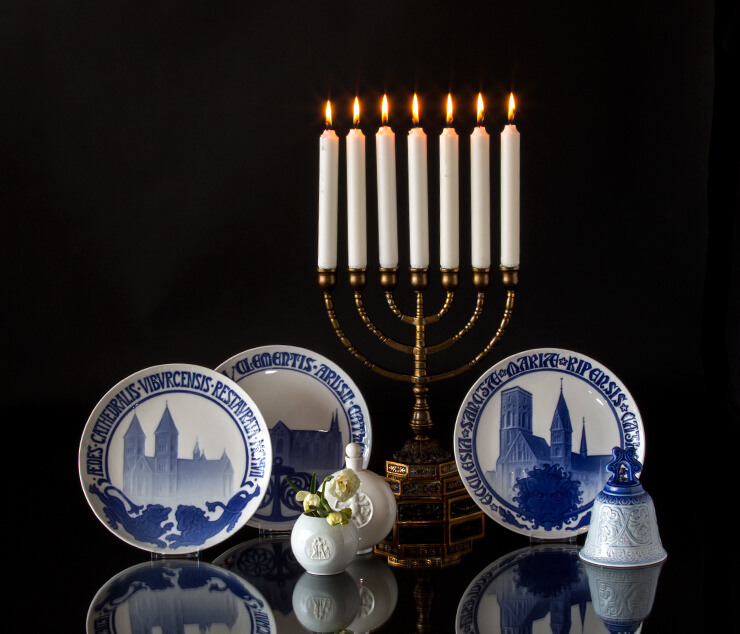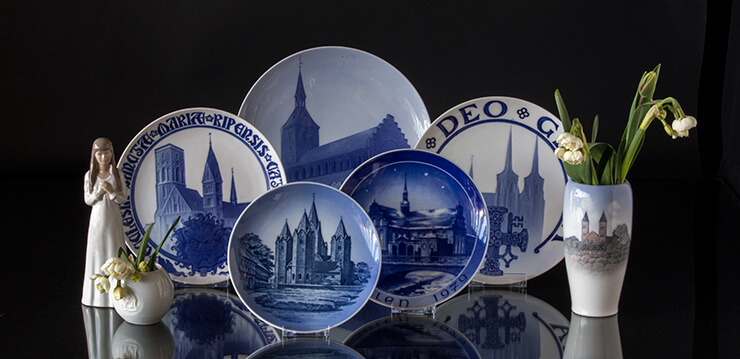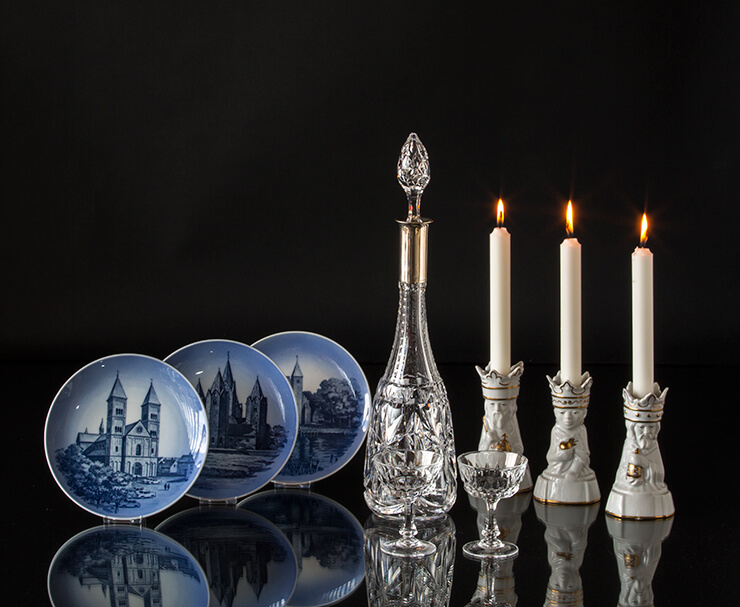
A number of different plates with the many old and beautiful Danish Churches have been made. The primary producers of plates with church motifs were Royal Copenhagen, Bing & Grondahl and Bareuther & Co. (BACO), who produced a series of church plates in underglaze for the Danish hardware chain Imerco. The Danish Cathedrals, Budolfi Cathedral in Aalborg Diocese, Haderslev Cathedral in Haderselv Diocese, Maribo Cathedral in Lolland-Falster Diocese, Ribe Cathedral in Ribe Diocese, Roskilde Cathedral in Roskilde Diocese, Saint Canute's Cathedral in Fyen Diocese, Saint Olai Cathedral in Helsingor Diocese, Viborg Cathedral i Viborg Diocese, Notre Dame Cathedral in Copenhagen Diocese and Aarhus Cathedral in Aarhus Diocese, are all represented amongst the church plates.

The vast majority of the Danish churches from the small parish churches to the large cathedrals are basilicas that are characterised by the long central rooms (nave) with small side rooms (side-aisles), which connects perpendicular to the nave. The basilica building was originally court buildings and public assembly halls in ancient Rome situated at the town's Forum. Both the basic shape and the location next to the central square of the town has been preserved in the town churches, which are often located by the town square. In ancient Rome it was court rulings and speeches, which took place in the basilicas and as these where public, the buildings where build to accommodate the public and allow them to both be able to hear and see the proceedings. This setup fitted the Christian Mass perfectly as it is also based on the congregation being able to hear and see the acts of the Mass unlike the heathen temples, where the cultic acts were not public. As the basilicas were thus well-suited for the Christian Mass and the preaching of the Gospel, they were quickly adapted to the Church, when Christianity was officially recognised by the Roman Empire in 313 during the reign of Constantine the Great. The most characteristic addition made by the Church to the basilica is the belfry that calls the congregation to Mass.
Among the churches other than the Cathedrals that have adorned the church plates the foremost must be the Marble Church in Frederik's Parish in Copenhagen. The Marble Church stands out by not being a classic basilica, but a round church with a dome, where the church room with the alter and the benches stand below the dome. The Marble Church began as a part of Frederiksstaden, which were to be a new district of Copenhagen, and the foundation stone was set in 1749. The church was situated at the end of the Amalienborg Axis that was the transverse axis of the district after the pattern of rococo building style. As indicated by the name Amalienborg, which is the current residence of the Danish Monarchy, was at the other end of the axis. The gigantic building project was later halted in 1770. Despite many suggestions no further work was done on the church until after 1874, when the industrialist C. F. Tietgen bought the church and personally financed the completion. The church could finally be inaugurated in 1894 145 years after the foundation stone was placed.
Another prominent church that has been used as a motif on the church plates are the Grundtvig Church that was build in memory of N. F. S. Grundtvig. Grundtvig was an important priest, psalmist and writer during the Danish Golden Age. He was a leading character in the Christian revival and reorganisation of the Church of Denmark in the 19th Century in Denmark. The foundation stone was placed in 1921 and the church was inaugurated in 1940 after 19 years under construction. The Grundtvig Church is a basilica with a very tall naveand a unique triple belfry, which gives it ist monumental appearance in the cityscape.

Amongst the more unique churches, which adorn the plates, is Osterlars Church on Bornholm in the Baltic Sea, which is the largest of the four round churches on Bornholm and build around 1150. The church room is special in that it is round and unlike the Marble Church, where the church benches stand in rows like in a normal nave, the benches in Osterlars follow the rounded wall of the room, thus hidding the alter from view for parts of the congregation due to the large central column in the room. As an added curiosity Osterlars Chruch also has frescos like Sct. Bendt's Church in Ringsted in Denmark most frescos were painted over during the reformation leaving only a limited number with intact frescos. The central column in Osterlars Church also carries the round roof of the church, which is carried by large wooden beams that go from the roof to the central column and lead the presure from the weight of the roof down through the center of the church. This is in contrast to the Marble Church, where the weight of the dome is geometrically set down through the sides, which are reinforced to carry the weight. This gives the large open room in the interior of the church.



 We are e-approved
We are e-approved





